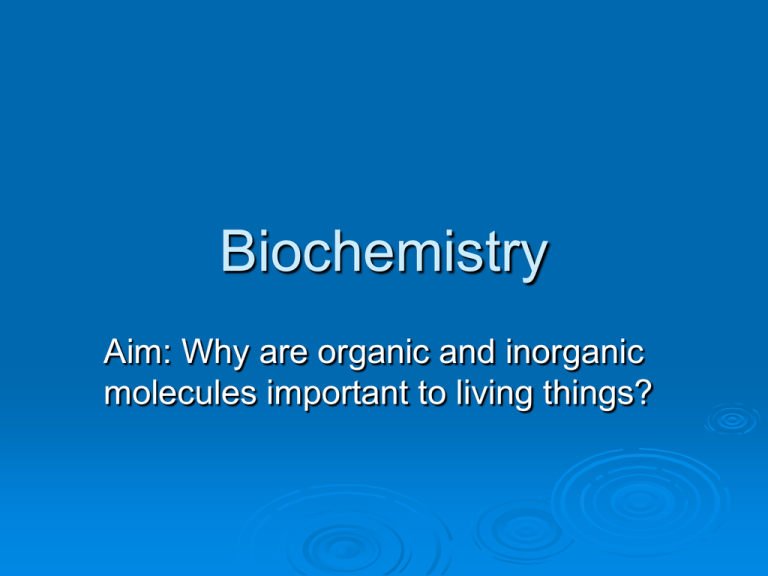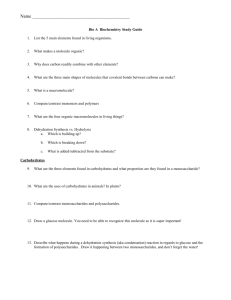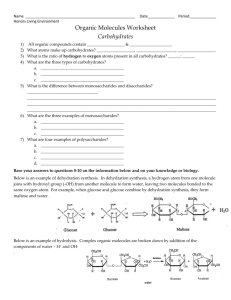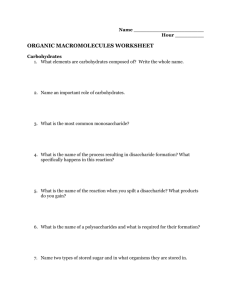Biochemistry
advertisement

Biochemistry Aim: Why are organic and inorganic molecules important to living things? I. Importance of Nutrients A. In order for each life process to occur, the body must possess 4 essential building blocks: 1. Carbohydrates 2. Lipids (fats) 3. Proteins 4. Nucleic Acids (DNA & RNA)**** I. Importance of Nutrients B.Three of the four important nutrients are found in our daily diet: 1. Carbohydrates 2. Lipids 3. Proteins I. Importance of Nutrients C. These nutrients are broken down to their simplest form or building blocks so that organisms can get: 1. Energy 2. Repair tissue 3. Synthesize 4. New tissue 5. Maintain homeostasis II. Organic vs. Inorganic A. Every chemical compound is either organic or inorganic…. What’s the difference??? II. Organic vs. Inorganic B. Inorganic compounds are compounds that do not contain both carbon and hydrogen. Example: •H2O *VERY IMPORTANT •CO2 II. Organic vs. Inorganic C. Organic Compounds are compounds that contain both carbon and hydrogen. Examples: Carbohydrates Lipids Proteins Nucleic Acids II. Organic vs. Inorganic D. Each of the 4 essential molecules contain both the elements carbon (C) and hydrogen (H) in their structure. H = Hydrogen C = Carbon O = Oxygen N = Nitrogen III. Carbohydrates A. Main source of energy (starches and sugars). B. Structural component of cells. C. Names of most sugars end in –ose. Example: glucose, lactose D. Usually contains 2 times as many H atoms as O atoms. Example: C6H12O6 glucose E. Monosaccharides 1. One molecule of carbohydrate 2. Building blocks of carbohydrates also called simple sugars. a. Glucose sweets, candy, cookies b. Fructose fruits c. Glucose, galactose, fructose all have same chemical formula, however are structurally different. E. Monosaccharides Glucose Galactose Fructose Structural Formula F. Disaccharides 1. Disaccharides: a. Two simple sugars (monosaccharides) combine by dehydration synthesis. b. Most common disaccharides have the molecular formula: C12H22O11: Maltose G. Polysaccharides 1. Three or more molecules of carbohydrates (complex carbohydrates). 2. Polysaccharides are long chains of monosaccharides. H. Examples of Polysaccharides 1. Starch: stored excess plant sugar 2. Glycogen: stored excess animal sugar Found in the liver of humans 3. Cellulose: found in cell walls 4. Chitin: exoskeleton I. Dehydration Synthesis 1. Process of removing water molecules to form a disaccharide or polysaccharides from monosaccharides. Example: Maltose C6H12O6 + C6H12O6 C12H22O11 + H2O Reactants Products J. Hydrolysis 1. Addition of water to breakdown complex molecules. 2. Exampledisaccharide to monosaccharide. 3. Opposite of dehydration synthesis. IV. Lipids A. Stored and used as an energy reserve. B. Cushions and prevents heat loss. C. Important in the structure of the cell membrane. Fats (solid at room temperature). Oils (liquids at room temperature). IV. Lipids D. Contain C, H and O. E. Less O than in carbohydrates. H and O not in a 2:1 ratio. F. Stored lipids that are needed for energy are broken down by hydrolysis. IV. Synthesis of Lipids G. Formed by the dehydration synthesis of 3 fatty acids and 1 glycerol (kind of alcohol). 3 fatty acids + 1 glycerol lipid + 3 H2O (long chain of C and H with 1 carboxyl group). (alcohol) (water) + 3 H2 O V. Proteins A. Contain C, H, O and N. Some contain S (sulfur). B. Used for the growth and repair of cells C. Building blocks are called amino acids. 20 different kinds. D. Structure of Amino Acids Amino Group Variable group (side chain) Central Carbon Carboxyl Group E. 20 Amino Acids What is the difference between Alanine and Valine? The Alanine has CH3 and Valine has 2 CH 3 and a CH coming off of it. What is the difference Tryptophan and Lysine? Tryptophan has a ring structure, 3 CH2 and a NH coming off of it and Lysine has 3 CH2 and a NH3 coming off of it. F. Where are proteins found?? 1. Hemoglobin: carries oxygen 2. Skin pigments: melanin 3. Hormones 4. Antibodies 5. Enzymes 6. Hair/nails 7. Cell membrane G. Peptides 1. The bond between 2 amino acids is called a peptide bond. 2. Dipeptide: 2 amino acids combined by the dehydration synthesis. Peptide Bond Dipeptide Structure H. Polypeptides 1. Chains of amino acids. 2. Proteins are composed of 1 or more polypeptide chains coiled or folded in a specific way. VI. pH scale A. Measure of how acidic a substance is. acidic neutral basic 0 7 14 B. Litmus paper indicates an acid or a base.







